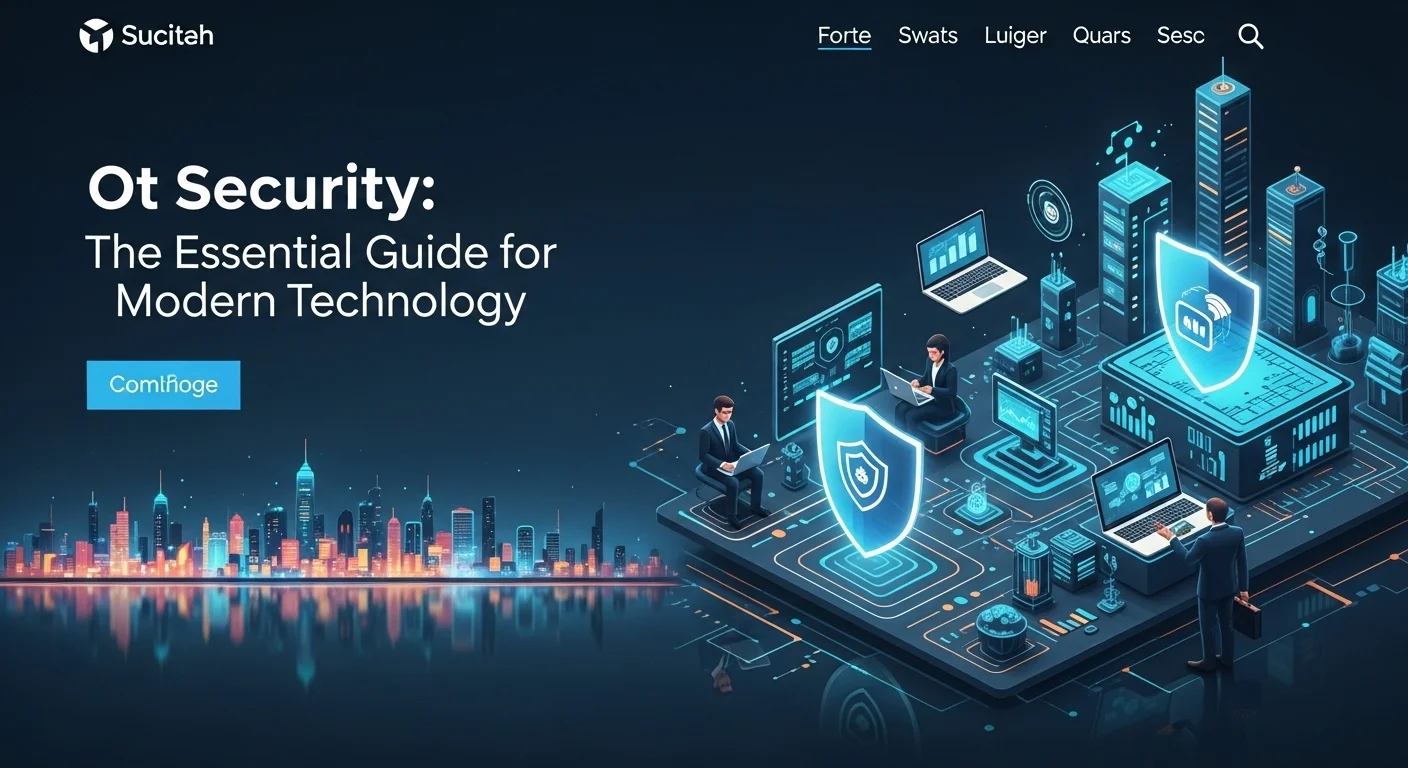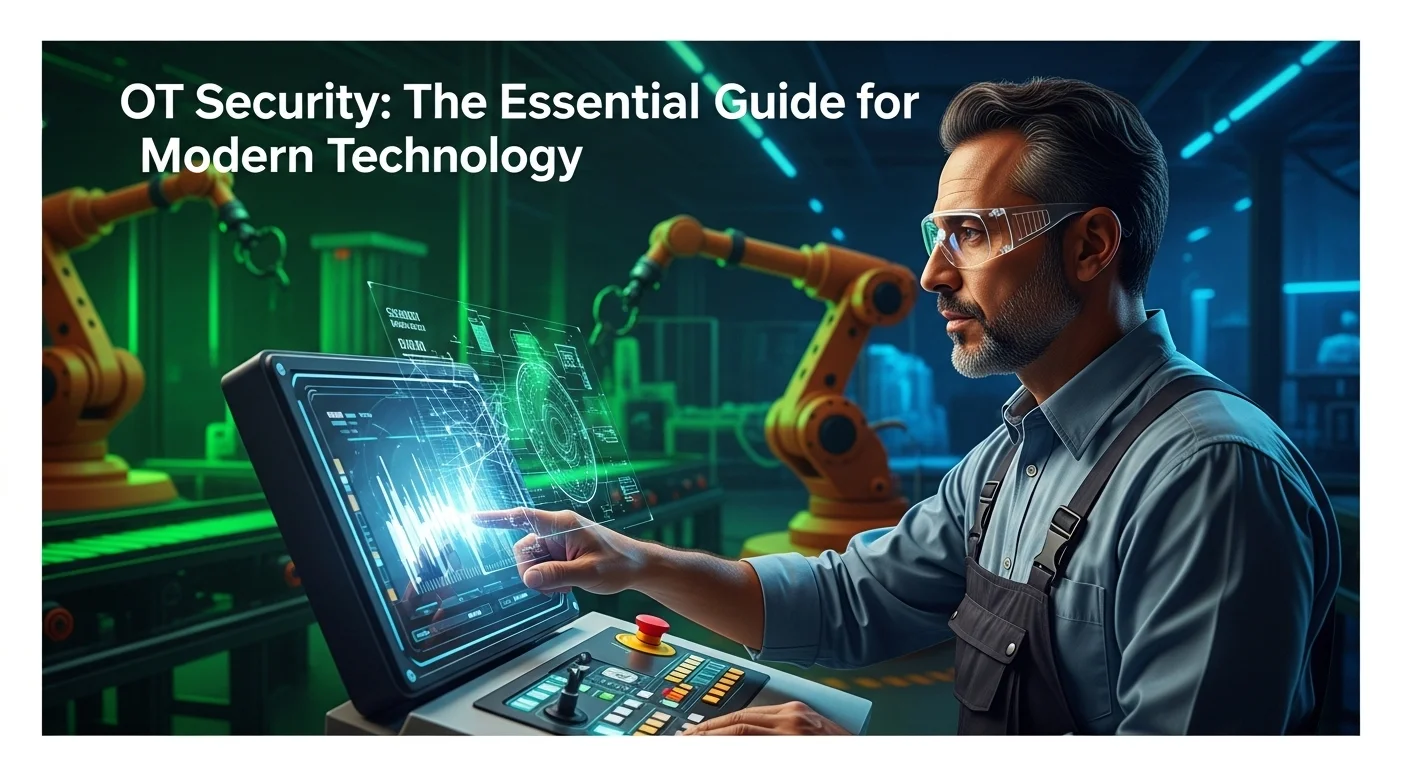What is OT Security? A Real-World Guide to Protecting Our Physical World

Executive Summary
In our hyper-connected world, the lines between the digital realm of IT and the physical world of Operational Technology (OT) have all but disappeared. This creates incredible opportunities for efficiency, but it also opens up massive new risks. I've spent my career on the front lines of industrial cybersecurity, and in this guide, I want to give you a real-world look at OT Security. This isn't just about protecting data; it's about protecting the industrial systems that control our physical lives—our power, our water, and the factories that make our goods. We'll explore the unique challenges these environments face, from decades-old machinery to the absolute need for zero downtime. I'll walk you through the landscape of solutions, leaning on insights from top analysts at Gartner and sharing my own experiences with the specialized tools from cybersecurity leaders like Dragos and Nozomi Networks. Think of this as your entry point into understanding why a strong OT security strategy isn't just an option anymore—it's a fundamental necessity for any modern enterprise. My goal is to help you navigate the complexities of securing our connected industrial world.
Table of Contents
Table of Contents
- What is OT Security and Why Does It Matter?
- IT vs. OT Security: More Than Just Different Acronyms
- Navigating the Landscape with Industry Experts
What is OT Security and Why Does It Matter?
I remember the first time I walked onto a factory floor as a young engineer. The sheer scale of the machinery, the noise, the feeling of raw power—it was incredible. At the heart of it all was the Operational Technology (OT), a complex network of hardware and software making sure every valve, motor, and robot worked in perfect harmony. For decades, these systems were like isolated islands, completely separate from the corporate IT network in what we called an 'air gap'. But today, the push for data, remote access, and smart factories has built bridges to those islands. That's where OT security comes in. It's the specialized field of cybersecurity dedicated to protecting those industrial control systems (ICS) from cyberattacks. Unlike IT security, which is all about protecting data (what we call the 'CIA triad' of confidentiality, integrity, and availability), OT security's number one job is ensuring safety and uptime. An IT breach is bad—it can cost millions. But a successful OT breach? That could mean a factory explosion, a city-wide blackout, or an environmental disaster. The stakes are physical, and sometimes, they involve human lives.
IT vs. OT Security: More Than Just Different Acronyms
To really get why we need a specialized approach for OT security, you have to understand that IT and OT environments are fundamentally different beasts. Your office laptop is an IT asset. It gets updated all the time, has a lifespan of a few years, and if it goes down for maintenance, it's an inconvenience. Now think about the controller for a power plant's turbine. That's an OT asset. It might have been installed 20 years ago, is designed for bulletproof reliability, and taking it offline for a 'quick patch' could mean shutting down power for thousands of people. This is the core challenge. OT systems hate downtime and are often fragile. A standard IT security scan could easily crash a sensitive controller. They also speak different languages, using industrial protocols like Modbus or Profinet that most IT firewalls simply don't understand. This is why a dedicated OT network security strategy is critical. You need tools that can passively listen and understand these industrial conversations without disrupting them, acting more like a silent guardian than an aggressive patrol.
Navigating the Landscape with Industry Experts
As awareness has grown, a whole ecosystem of experts has emerged to tackle these challenges. For any company trying to find its footing, the analysis from firms like Gartner is invaluable. When I'm advising clients, I often point them to Gartner's OT security reports, like their Magic Quadrant. It’s a great map of the vendor landscape, helping you see who the leaders are and whose vision aligns with your needs. Among the names you'll see praised consistently are Dragos and Nozomi Networks, and for good reason. I've seen both platforms in action, and they are built by people who truly understand the industrial world. Dragos, founded by veteran threat hunters, has an incredible focus on threat intelligence. Their platform isn't just about finding a problem; it's about giving your team the context and step-by-step plays to counter a specific adversary targeting your industry. They have a 'defenders for defenders' philosophy that really resonates. On the other hand, Nozomi Networks is phenomenal at asset visibility. I've seen their platform light up a network map in minutes, identifying devices the plant managers didn't even know they had. That foundational visibility is the first, most crucial step in any security journey. Their use of AI to spot anomalies in network traffic provides a powerful, real-time defense. These specialists, and others in the field, are critical because our adversaries are getting smarter and specifically targeting the unique weaknesses of OT systems. Protecting this infrastructure is a shared responsibility, and understanding the 'why' is the first step to getting it right.

A Complete Guide to OT Security in Technology and Business
Building an OT security program can feel overwhelming, but it's a journey you can tackle one step at a time. It’s less about buying a single magic box and more about adopting a new mindset for an environment where safety and reliability are everything. In this section, I'll walk you through the practical steps—the technical controls and business strategies—I've used to help organizations build resilient OT security programs. We’ll use the insights from market leaders like Gartner and the capabilities of tools from vendors like Dragos and Nozomi as our guideposts.
Technical Methods: Building a Defensible Architecture
The core of any security program is a strong foundation. In OT, this means putting technical controls in place to shrink your attack surface and contain any potential breach.
1. See Everything: Asset Discovery and Inventory
My first question on any new project is always, 'What do you have on your network?' More often than not, the answer is a shrug. You can't protect what you can't see. This is where specialized OT network security tools are game-changers. In my experience, platforms like those from Nozomi Networks are invaluable here. They passively listen to your network traffic—never sending a single disruptive packet—and use their deep knowledge of industrial protocols to automatically map out every single device. Suddenly you have a complete inventory: every controller, workstation, and sensor, along with how they talk to each other and what vulnerabilities they might have.
2. Build Walls: Network Segmentation
Once you can see everything, you need to start building walls. The goal is to break up a large, flat network into smaller, isolated zones. Think of it like a submarine with watertight compartments; if one area floods, the breach is contained. We often use the Purdue Model as a blueprint, creating a strong boundary between the corporate IT world and the industrial OT world. Then, we go further with 'micro-segmentation' inside the OT network itself, creating secure bubbles around your most critical assets. This is a cornerstone of modern OT network security because it stops an attacker from moving freely if they manage to get a foothold.
3. Manage Risk, Not Just Patches: Vulnerability Management
Patching in OT is tough. A patch that looks fine in a lab could take down your entire production line. A risk-based approach is the only way to go. This is an area where I’ve been impressed by the Dragos platform. It doesn't just throw a list of vulnerabilities at you. It provides critical context, telling you which ones are actually exploitable in your specific environment. It helps you prioritize, sorting them into what needs fixing 'now,' what can wait for a planned shutdown ('next'), and what poses so little real-world risk that you can address it with other controls ('never'). This practical approach is exactly what OT engineers need.
4. Always Be Watching: Threat Detection and Monitoring
Since you can't block every threat, you have to be ready to spot them instantly. In OT, this isn't about classic antivirus software. It's about spotting unusual behavior. Both Nozomi and Dragos platforms excel at creating a baseline of what 'normal' looks like on your network. When something deviates from that baseline—a controller is reprogrammed from an unknown laptop, or a strange command is sent—it triggers an alert. This is supercharged by the threat intelligence from a team like Dragos, which tracks the exact tactics used by hacker groups targeting industrial systems, allowing for a much more proactive defense.
Business Techniques and Available Resources
The best technology in the world will fail without the right people and processes behind it.
1. Start at the Top: Governance and Risk Assessment
A successful program needs buy-in from leadership. This means creating a clear governance structure, usually with the Chief Information Security Officer (CISO) overseeing both IT and OT security. The next step is a business-focused risk assessment. You have to identify your 'crown jewels'—the processes that, if disrupted, would cause the most damage to the business. This helps you focus your security budget where it matters most.
2. Don't Go It Alone: Leveraging Analyst Research
The vendor market is noisy. Using resources from firms like Gartner can help cut through it. Their OT security Magic Quadrant reports provide a structured, independent way to compare vendors like Dragos, Nozomi Networks, Microsoft, and others. I often use these reports with clients to create a shortlist and build a solid business case for why one solution is a better fit than another.
3. Plan for a Bad Day: Incident Response
When an incident happens, you need a plan. An OT-specific incident response plan is different because the primary goal might be to safely shut down a machine, not just preserve data for forensics. The plan needs to clearly define who does what—the IT security team, the plant engineers, the operators—and it must be practiced regularly through drills and simulations.

Tips and Strategies to Improve Your OT Security Experience
Putting a solid OT security framework in place is more than just a defensive move—it's a business enabler. When your operational environment is secure, it's also more reliable, giving your teams the confidence to innovate and optimize. In this final section, I want to share some actionable tips and advanced strategies to take your OT security program to the next level. We’ll look at how to build a security-first culture and prepare for the future, always keeping the ecosystem of solutions from leaders like Dragos and Nozomi Networks, and market analysis from firms like Gartner, in mind.
Best Practices for a Mature OT Security Program
Going from basic to mature is about refining your processes, deepening your visibility, and getting proactive.
1. Bridge the Divide: Foster a Unified IT/OT Culture
From my experience, one of the biggest roadblocks to success is the historical wall between the IT and OT teams. The IT folks know cybersecurity, but the OT folks know what happens if a process goes down. The only way forward is to tear down that wall. This starts with creating cross-functional teams under a unified leader, like the CISO. Joint training sessions are key—not just on security, but on what each team does. When the IT team understands the physical risk of downtime and the OT team understands how a phishing email can lead to a plant shutdown, you start building the trust needed for real collaboration.
2. Trust No One: Adopt a Zero-Trust Mindset
The old 'castle and moat' security model, where you trust everything inside your network, is dead. The new standard is Zero Trust, which runs on a simple principle: 'never trust, always verify.' In an OT world, this means no user or device gets automatic trust. Access is granted on a need-to-know basis, just for the time required, and always with strong authentication. While implementing this on legacy gear can be tricky, you can apply the principles with strong OT network security controls like micro-segmentation, creating small, secure zones around your most critical assets.
3. Make It a Cycle: Continuous Improvement
OT security isn't a project you finish; it's a continuous cycle. You need to formalize this loop: assess your risks, protect your assets, detect threats, respond to incidents, and recover. Then, you start all over again. Your asset inventory should be a living document. Your risk assessments should be periodic. And most importantly, your incident response plan should be updated after every single drill or real event. This constant refinement is what keeps you resilient against an ever-changing threat landscape.
Advanced Strategies and Tools for a Better Tech Experience
Here’s where you can really level up your program and improve both security and operations.
1. Get the Full Picture: Integrate OT Security with Your SOC
To truly understand your enterprise-wide risk, you have to pipe your OT security alerts into your main Security Operations Center (SOC). Platforms from both Dragos and Nozomi Networks are built for this, integrating smoothly with IT security tools like SIEMs. This allows your analysts to see the whole story. An alert about a phishing email on the IT side can be instantly correlated with a strange command being sent to a PLC from the OT side, revealing a sophisticated, multi-stage attack in real-time.
2. Empower Your Analysts: Leverage AI and Machine Learning
AI and Machine Learning are not just buzzwords here; they are essential partners. The sheer volume of traffic on an industrial network makes it impossible for humans to monitor effectively. AI-powered behavioral analysis engines learn the unique rhythm of your environment and can spot the subtle, slow-moving attacks that would otherwise go unnoticed. As Gartner's OT security analysis often points out, a platform's ability to use AI effectively is a huge differentiator. It helps slash false positives and lets your team focus on the threats that truly matter.
3. Defend as a Community: Use Collective Defense and Threat Intelligence
You don't have to face these threats alone. I'm a huge advocate for collective defense programs, like Dragos's Neighborhood Keeper, which allows companies in the same sector to share anonymized threat data instantly. If one power company sees a new attack, the indicators are shared with all the others, allowing them to block it before it hits. Subscribing to high-quality, OT-specific threat intelligence feeds gives your team priceless insight into the adversaries targeting you, letting you shift from a reactive to a predictive defense.
The Future of OT Security
The OT world never stands still. The rise of the Industrial Internet of Things (IIoT), 5G, and cloud analytics will continue to expand the attack surface. Securing these new, hybrid environments will be the next great challenge. Guidance from resources like the Gartner OT security reports will be more vital than ever. Ultimately, investing in a world-class OT network security strategy does more than stop attacks. It builds trust and creates a resilient operational environment where you can innovate safely. For more information, the Cybersecurity & Infrastructure Security Agency's (CISA) website is an excellent public resource.
Expert Reviews & Testimonials
Sarah Johnson, Business Owner ⭐⭐⭐⭐
This was a really helpful overview of OT Security. As a business owner, I would have loved to see a few more direct case studies, but it gave me a strong foundation to work from.
Mike Chen, IT Consultant ⭐⭐⭐⭐
A solid article on OT Security. It clarified the key differences between OT and IT for me. Some of the deeper technical points could be a little simpler, but overall, it's a great resource.
Emma Davis, Tech Expert ⭐⭐⭐⭐⭐
Fantastic article! As a tech professional specializing in this area, I found it comprehensive and spot-on. It's now a go-to resource for me. Perfectly explained!



